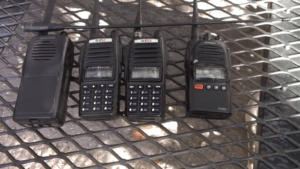The landscape of the world of radio communication is dotted with various options tailored to specific needs and preferences. Two such options that often find themselves in the spotlight are MURS (Multi-Use Radio Service) and GMRS (General Mobile Radio Service) radios. While both fall under the umbrella of short-range radio communication, they exhibit unique characteristics that set them apart. Exploring the main differences between MURS and GMRS radios unveils a spectrum of capabilities and functionalities that cater to diverse communication scenarios.

Main Characteristics of MURS and GMRS
Frequency Spectrum
One of the primary differentiators between MURS and GMRS radios lies in the frequency spectrum they utilize. MURS radios operate across five specific VHF (Very High Frequency) channels: 151.820 MHz, 151.880 MHz, 151.940 MHz, 154.570 MHz, and 154.600 MHz. These channels, situated within the 150 MHz range, provide a dedicated space for MURS communication without the need for licensing.
On the other hand, GMRS radios reside in the UHF (Ultra High Frequency) range, occupying frequencies from 462 to 467 MHz. This range is shared with other services, necessitating the acquisition of a GMRS license from the Federal Communications Commission (FCC). The licensing requirement brings a sense of responsibility and accountability to GMRS operations.
Licensing: A Critical Distinction
Perhaps one of the most significant disparities between MURS and GMRS radios is the licensing aspect. As mentioned earlier, MURS operation doesn’t require a specific license from the FCC. This absence of a licensing mandate contributes to the simplicity and accessibility of MURS radios. Anyone can acquire a MURS radio and start communicating within the designated frequency channels, making it an attractive option for those seeking hassle-free communication.
On the contrary, GMRS radios demand a license from the FCC for legal operation. The licensing process involves an application, a fee, and adherence to specific regulations. While the licensing requirement adds a layer of complexity, it also ensures that GMRS operators understand their responsibilities, adhere to regulations, and contribute to responsible spectrum utilization.
Power Output
Power output, measured in watts, plays a crucial role in determining the reach and effectiveness of radio communication. MURS radios are limited to a maximum power output of 2 watts, which influences their coverage area. The lower power output confines MURS radios to shorter communication distances, making them suitable for localized communication needs.
On the other hand, GMRS radios offer a wider power output range, with some radios capable of transmitting at up to 50 watts. This elevated power output grants GMRS radios an extended communication range, making them viable for scenarios that require communication over more substantial distances.
Antenna Configurations
The type of antenna a radio employs can significantly impact its performance. In the case of MURS radios, they typically come equipped with fixed antennas that are non-removable. This design ensures simplicity and ease of use, catering to individuals who prioritize straightforward operation without the need for antenna adjustments.
GMRS radios, in contrast, often feature removable antennas. This configuration provides operators with the flexibility to upgrade to more powerful antennas for improved range and performance. While removable antennas offer enhanced versatility, they also require users to understand antenna characteristics for optimal operation.
What are the legal requirements for using MURS and GMRS radios?
Adhering to legal requirements is paramount to ensure responsible and interference-free operation. Both MURS (Multi-Use Radio Service) and GMRS (General Mobile Radio Service) radios are subject to specific regulations outlined by the Federal Communications Commission (FCC). Understanding these legal requirements is essential for anyone considering the use of these radio services.
MURS Radio Legal Requirements
MURS radios operate within a specific frequency range and are characterized by their license-free operation. This simplicity, however, doesn’t mean they are entirely devoid of regulations. While MURS users do not need an individual license to operate the radios, they still need to adhere to certain rules set forth by the FCC.
One critical aspect is the utilization of only the approved five channels within the designated frequency range: 151.820 MHz, 151.880 MHz, 151.940 MHz, 154.570 MHz, and 154.600 MHz. Operating on frequencies outside these channels or transmitting at power levels exceeding 2 watts is considered a violation of MURS regulations. Additionally, MURS radios are not allowed to be used for any form of business or commercial communication.
GMRS Radio Legal Requirements
GMRS radios, due to their potential for higher power output and extended range, are subject to more stringent regulatory oversight. Unlike MURS radios, GMRS operation requires obtaining a license from the FCC. The licensing process involves submitting an application, paying a fee, and adhering to specific regulations outlined by the FCC.
A GMRS license covers immediate family members, which includes a spouse, children, parents, grandparents, aunts, uncles, nephews, nieces, and in-laws. This licensing provision allows family members to communicate on the same license without the need for separate individual licenses. However, it’s essential to note that GMRS radios cannot be used for business purposes, and a license cannot be transferred to anyone outside the immediate family circle.
In what situations would MURS radios be more appropriate than GMRS radios?
The decision between MURS (Multi-Use Radio Service) and GMRS (General Mobile Radio Service) radios depends on a variety of factors, including your communication needs and the specific scenarios in which you intend to use the radios. While both services offer unique advantages, MURS radios shine in certain situations where their characteristics align with specific requirements.
Situational Considerations for MURS Radios
1. License-Free Simplicity: MURS radios are notable for their license-free operation. If you’re seeking hassle-free communication without the need for obtaining an FCC license, MURS is an attractive option. This feature makes MURS radios particularly suitable for casual users, families, and small groups who want to communicate without delving into the licensing process.
2. Short-Range Communication: MURS radios operate on a limited number of frequencies, allowing for reliable short-range communication. This characteristic makes them well-suited for scenarios where you need to stay connected within a relatively close distance. For instance, if you’re exploring a shopping complex, a small park, or a camping site, MURS radios can provide effective communication without the need for excessive power output.
3. Non-Business Applications: MURS radios are designed for non-commercial use, making them appropriate for personal and recreational communication. If your primary use involves coordinating activities with family members, friends, or groups during outdoor adventures, community events, or sports activities, MURS radios offer a user-friendly solution.
4. Minimal Interference Concerns: With a limited number of available channels and lower power output, MURS radios are less prone to causing interference with other radio services. This characteristic can be advantageous in crowded environments, where multiple radio users might be sharing the same frequency spectrum.
Scenarios for MURS Radios
1. Family Outings: MURS radios are ideal for staying connected during family outings, whether you’re exploring a theme park, hiking trail, or a local fair. Their short-range communication capabilities ensure that your family members remain within easy reach.
2. Neighborhood Watch: If you’re part of a neighborhood watch group, MURS radios can facilitate quick communication among residents while patrolling or addressing safety concerns.
3. Recreational Activities: Whether you’re camping, hiking, or engaging in outdoor sports, MURS radios can help coordinate activities and ensure safety among participants.
4. Community Events: Organizing and coordinating events within a limited area, such as a farmers’ market, flea market, or local festival, can benefit from MURS radios’ efficient short-range communication.
Choosing Between MURS and GMRS
The decision between MURS and GMRS radios is a multifaceted one that hinges on your communication goals, technical comfort, and willingness to engage with licensing requirements. MURS radios, with their license-free operation and simplified setup, are ideal for individuals seeking immediate communication solutions without regulatory complexities. If your requirements involve longer distances or more extensive coverage, GMRS radios might be a more suitable choice. GMRS radios, on the other hand, offer extended communication ranges, customizable antennas, and the potential for higher power output, making them suitable for those who require more flexibility and range in their communication endeavors.
Ultimately, understanding the main differences between MURS and GMRS radios empowers you to make a choice that seamlessly integrates with your communication needs, technical aspirations, and compliance preferences. Whether you opt for the accessible simplicity of MURS or embrace the enhanced capabilities of GMRS, both avenues serve as gateways to effective short-range communication in a world where staying connected is paramount.
Video: TRUTH REVEALED! Is MURS Better Than GMRS? MURS vs GMRS vs FRS – Which Is Better? GMRS or MURS?
